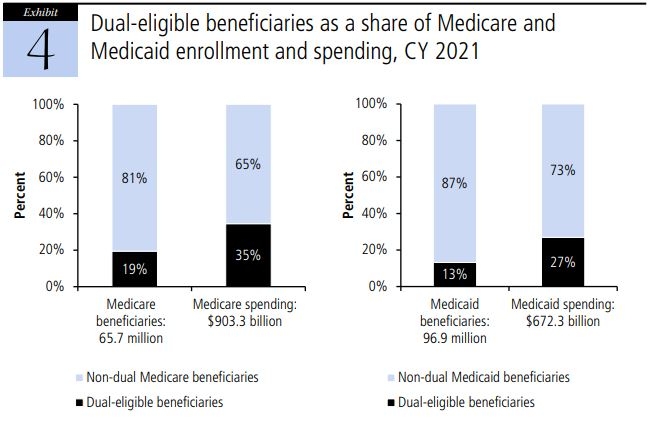New data book provides dual-eligible landscape

By HME News Staff
Updated 9:48 AM CST, Tue January 23, 2024

WASHINGTON – People who are dually eligible for Medicare and Medicaid account for a disproportionate share of spending in both programs, according to an updated data book from MedPAC and MACPAC.
Dual-eligible beneficiaries totalled 19% of the Medicare population in 2021 but accounted for 35% of Medicare spending. Similarly, dual-eligible beneficiaries accounted for 13% of all Medicaid beneficiaries but 27% of Medicaid spending.
“The existence of separate Medicaid and Medicare funding streams can create barriers to coordination of care for dual-eligible beneficiaries, which in turn can lead to increased costs and poor health outcomes,” the agencies state. “These issues are of particular concern given the high health needs of many dual-eligible beneficiaries and the fact that this relatively small group accounts for a disproportionate share of both Medicare and Medicaid spending.”
The data book, “Beneficiaries Dually Eligible for Medicare and Medicaid,” describes the dual-eligible population’s composition, service use and spending in calendar year 2021, as well as, new this year, the overlap in Medicaid and Medicare managed care enrollment.
Other key findings in the data book:
-
There were 12.8 million people who were dually eligible for Medicare and Medicaid for at least one month in 2021 (exhibit 1).
-
Reflecting the continued shift from fee-for-service (FFS) to managed care in Medicare and Medicaid, less than half of dual-eligible beneficiaries (42%) were enrolled only in Medicare FFS in 2021, 46% were in managed care only, and 13% spent part of the year in FFS and part of the year in managed care (exhibit 11). For Medicaid services, 42% of dual-eligible beneficiaries had at least one month of comprehensive managed care enrollment (exhibit 12).
-
One-quarter (25%) of all dual-eligible beneficiaries had at least one month in which they were simultaneously enrolled in a Medicare managed care plan and a comprehensive Medicaid managed care plan. Another 48% of all dual-eligible beneficiaries had some enrollment in Medicare managed care and/or comprehensive Medicaid managed care but not simultaneously (exhibit 13).
Comments